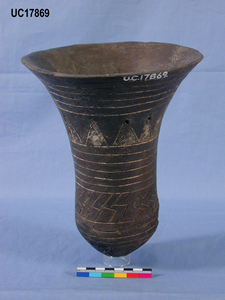|
Other Archaeological Sites / The Neolithic of the Levant (500 Page Book Online) Neolithic Badarian Culture (4400-4000 BC)
Selected Excerpt on the Badarian Culture
The Oxford Illustrated History of Ancient Egypt Excerpts and Definitions and Addendums Chapter 2: PreHistory: From the Paleolithic to the Badarian Culture The Badarian Culture is the earliest attestation of agriculture in Upper Egypt and was first identified in the region of Badari near Sohag. A large number of mainly small sites yielded a total of about 600 graves and 40 poorly documented settlements. The chronological position of the Badarian Culture is still the subject of some debate. Its relative chronological position in relation to the more recent Naqada Culture was established some time ago through excavation at the stratified site of North Spur Hammamiya. The culture might have already existed by about 5000 BC but it can only be definitely confirmed to have spanned the period around 4400-4000 BC. The existence of a still earlier culture called the Tasian (Deir Tasa) has been claimed. The culture would have been characterized by the presence of calcium beakers with incised designs which are also known from contexts of similar date in Neolithic Sudan. The existence however of the Tasian as a chronologically or culturally seperated unit has never been demonstrated beyond doubt. Although most scholars consider the Tasian to be simply part of the Badarian Culture it has also been argued that the Tasian represents the continuation of a Lower Egyptian tradition which would be the immediate predecessor of the Naqada I Culture. This seems however implausible first because similarities with the Lower Egyptian Neolithic cultures are not convincing and secondly because of the Tasian's obvious ceramic links with the Sudan. If the Tasian must be considered as a seperate cultural entity then it might represent a nomadic culture with a Sudanese background and which interacted with the Badarian Culture.
Analysis of Badarian grave goods and the placement of the wealthier graves in one part of the cemetery clearly seems to indicate social stratification which still seems limited at this point in Egyptian prehistory but which became increasingly important throughout the subsequent Naqada Period. The pottery that accompanies the dead in their graves is the most characteristic element of the Badarian Culture. The rippled surface that is present on the finest pottery comes from the surface having been combed with an instrument and then afterwards polished to result in a very decorative effect. The lithic industry is mainly known from settlement sites although the finest examples have been found in graves. It is principally a flake and blade industry to which a limited number of remarkable bifacial worked tools are added. Predominant tools are end-scrapers -- perforators -- retouched pieces. Bifacial tools consist mainly of axes -- bifacial sickles -- concave-base arrowheads. It should also be noted that the characteristic side-blow flakes were also present in the Western Desert. For a long time it was thought that the Badarian Culture remained restricted to the Badari region. Characteristic Badari finds have however also been found much further to the south at Mahgar Dendera -- Armant-- Elkab -- Hierakonpolis and also to the east in the Wadi Hammamat. Originally the Badarian Culture was considered a chronologically seperate unit out of which the Naqada Culture developed. However the situation is certainly far more complex. For instance the Naqada I Period seems to be poorly represented in the Badari region; therefore it has been suggested that the Badarian was largely contemporary with the Naqada I Culture in the area to the south of the Badari region. However since a limited number of Badarian or related artefacts have also been discovered south of Badari it might instead be argued that the Badarian Culture was present between at least the Badari region and Hierakonpolis. Unfortunately most of these finds are very limited in number and a comparison with the lithic industry or the settlement ceramics from the Badari area is in most cases impossible or has not yet been published. The Badarian Culture may therefore have been characterised by regional differences with the unit in the Badari region itself being the only one that has so far been properly investigated or attested. On the other hand a more or less uniform Badarian Culture may have been represented over the whole area between Badari and Hierakonpolis but since the development of the Naqada Culture [also] took place more to the south it seems quite possible that the Badarian survived for a longer time in the Badari region itself. The origins of the Badarian are equally problematic. It seems that the Badarian Culture did not appear from a single source although the Western Desert was probably the predominant one. On the other hand the provenance of domesticated plants remains controversial; an origin in the Levant via the Lower Egyptian Faiyum and Merimda Cultures might be possible. Evidence from Badarian settlements shows that the economy of the culture was primarily based on agriculture and animal husbandry. Among the content of storage facilities wheat -- barley -- lentils -- tubers have been found. Furthermore fishing was certainly very important and may have been the principal economic activity during certain period of the year. Hunting on the other hand was apparently of marginal importance ... |
